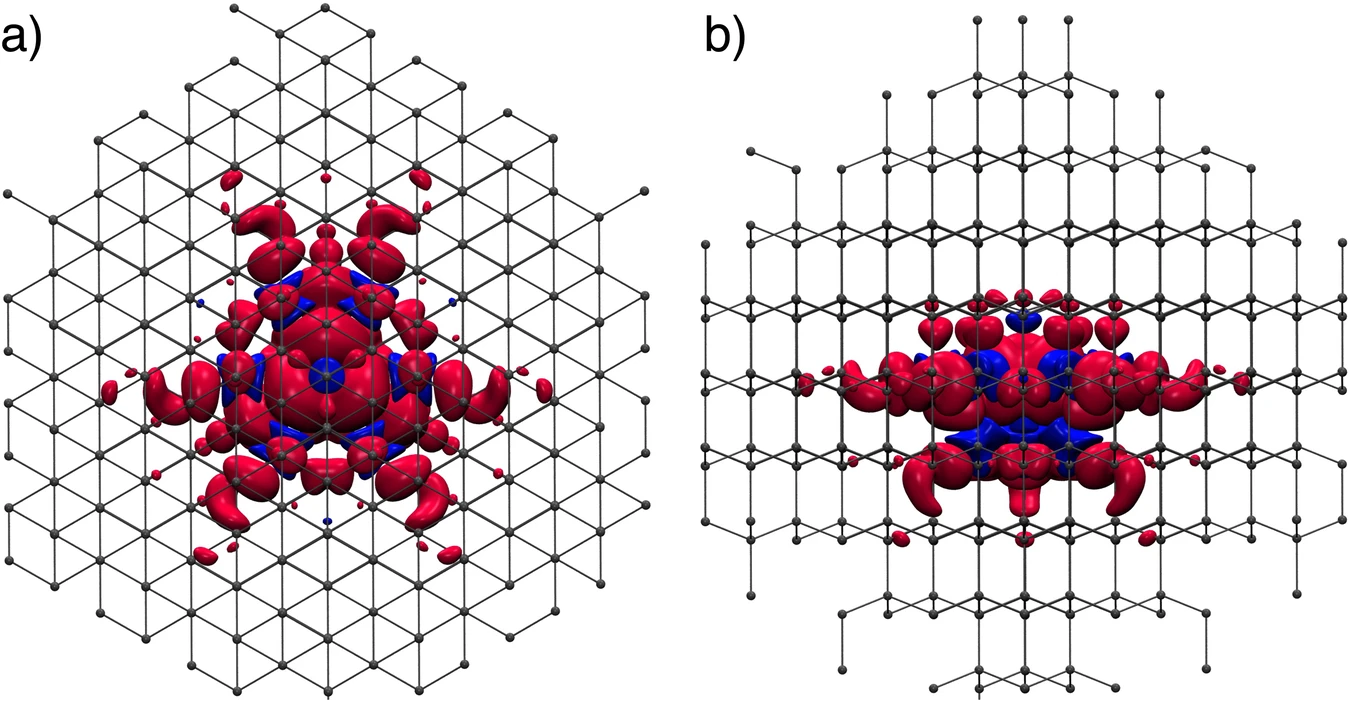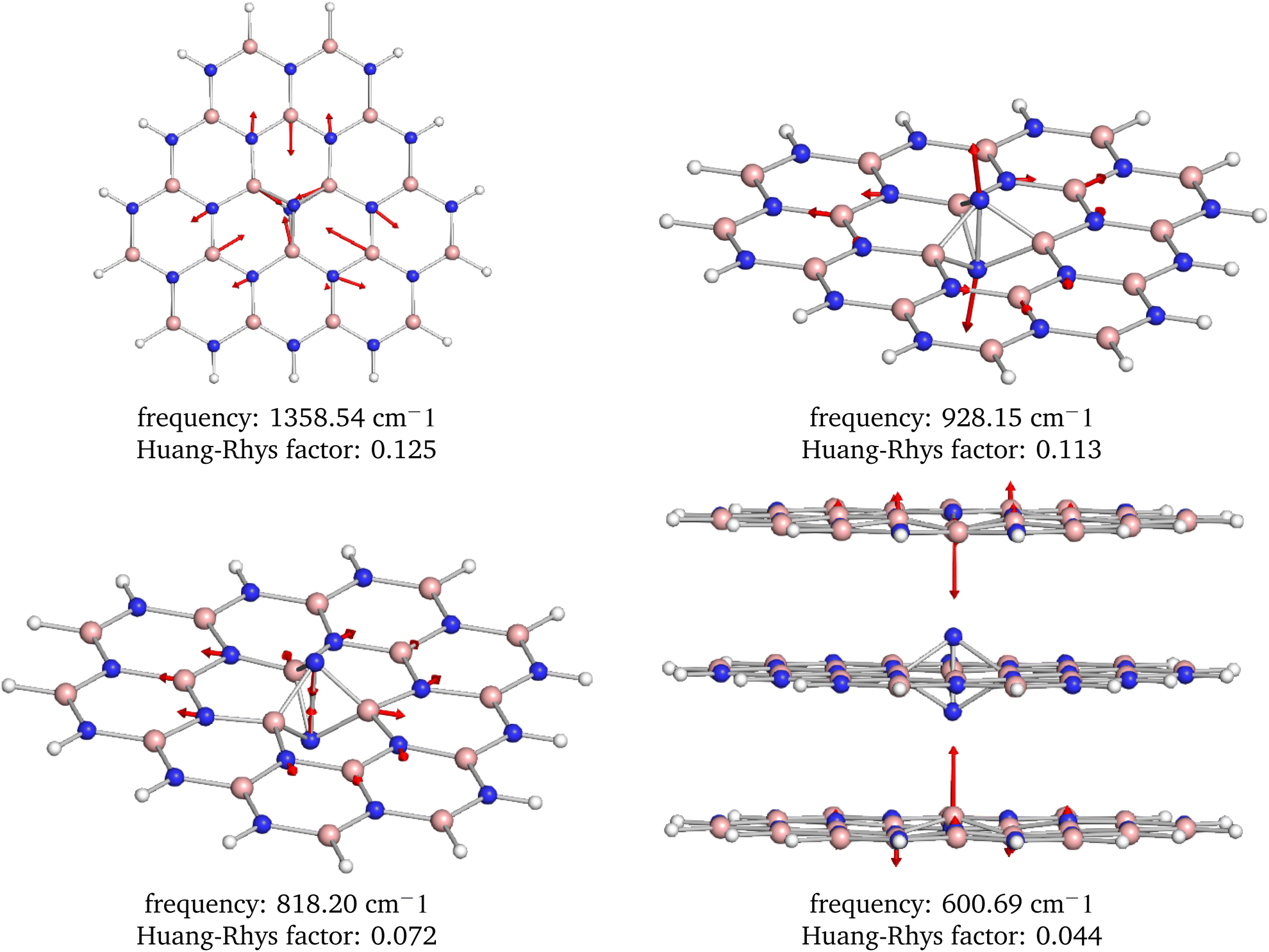Publications
Featured articles from the last 2 years

Babar, R., Barcza, G., Pershin, A. et al. Low-symmetry vacancy-related spin qubit in hexagonal boron nitride. npj Comput Mater 10, 184 (2024)
Point defect qubits in semiconductors have demonstrated their outstanding capabilities for high spatial resolution sensing generating broad multidisciplinary interest.
Hexagonal boron nitride (hBN) hosting point defect qubits have recently opened up new horizons for quantum sensing by implementing sensing foils. The sensitivity of point defect sensors in hBN is currently limited by the linewidth of the magnetic resonance signal, which is broadened due to strong hyperfine couplings.
Here, we report on a vacancy-related spin qubit with an inherently low symmetry configuration, the VB2 center, giving rise to a reduced magnetic resonance linewidth at zero magnetic fields. The VB2 center is also equipped with a classical memory that can be utilized for storing population information. Using scanning transmission electron microscopy imaging, we confirm the existence of the VB2 configuration in free-standing monolayer hBN.
Takács, I., Ivády, V. Accurate hyperfine tensors for solid state quantum applications: case of the NV center in diamond. Commun Phys 7, 178 (2024).
The decoherence of point defect qubits is often governed by the electron spin-nuclear spin hyperfine interaction that can be parameterized by using ab inito calculations in principle.
So far most of the theoretical works have focused on the hyperfine interaction of the closest nuclear spins, while the accuracy of the predictions for distinct nuclear spins is barely discussed. Here we demonstrate for the case of the NV center in diamond that the absolute relative error of the computed hyperfine parameters can exceed 100% using an industry standards first-principles code.
To overcome this issue, we implement an alternative method and report on significantly improved hyperfine values with O(1%) relative mean error at all distances. The provided accurate hyperfine data for the NV center enables high-precision simulation of NV quantum nodes for quantum information processing and positioning of nuclear spins by comparing experimental and theoretical hyperfine data.


Ganyecz, Á., Babar, R., Benedek, Z., Aharonovich, I., Barcza, G., & Ivády, V. (2024). First-principles theory of the nitrogen interstitial in hBN: a plausible model for the blue emitter. Nanoscale, 16(8), 4125-4139
Color centers in hexagonal boron nitride (hBN) have attracted considerable attention due to their remarkable optical properties enabling robust room temperature photonics and quantum optics applications in the visible spectral range.
On the other hand, identification of the microscopic origin of color centers in hBN has turned out to be a great challenge that hinders the in-depth theoretical characterization, on-demand fabrication, and development of integrated photonic devices. This is also true for the blue emitter, which is a result of irradiation damage in hBN, emitting at 436 nm wavelength with desirable properties. Here, we propose the negatively charged nitrogen split interstitial defect in hBN as a plausible microscopic model for the blue emitter.
To this end, we carried out a comprehensive first-principles theoretical study of the nitrogen interstitial. We carefully analyzed the accuracy of first-principles methods and showed that the commonly used HSE hybrid exchange–correlation functional fails to describe the electronic structure of this defect. Using the generalized Koopman’s theorem, we fine-tuned the functional and obtained a zero-phonon photoluminescence (ZPL) energy in the blue spectral range. We showed that the defect exhibits a high emission rate in the ZPL line and features a characteristic phonon side band that resembles the blue emitter’s spectrum.
Furthermore, we studied the electric field dependence of the ZPL and numerically showed that the defect exhibits a quadratic Stark shift that is perpendicular to plane electric fields, making the emitter insensitive to electric field fluctuations in the first order. Our work emphasizes the need for assessing the accuracy of common first-principles methods in hBN and exemplifies a workaround methodology. Furthermore, our work is a step towards understanding the structure of the blue emitter and utilizing it in photonics applications.
Benedek, Z., Babar, R., Ganyecz, Á. et al. Symmetric carbon tetramers forming spin qubits in hexagonal boron nitride. npj Comput Mater 9, 187 (2023).
Point defect quantum bits in semiconductors have the potential to revolutionize sensing at atomic scales. Currently, vacancy-related defects are at the forefront of high spatial resolution and low-dimensional sensing.
On the other hand, it is expected that impurity-related defect structures may give rise to new features that could further advance quantum sensing in low dimensions. Here, we study the symmetric carbon tetramer clusters in hexagonal boron nitride and propose them as spin qubits for sensing. We utilize periodic-DFT and quantum chemistry approaches to reliably and accurately predict the electronic, optical, and spin properties of the studied defect.
We show that the nitrogen-centered symmetric carbon tetramer gives rise to spin state-dependent optical signals with strain-sensitive intersystem crossing rates. Furthermore, the weak hyperfine coupling of the defect to their spin environments results in a reduced electron spin resonance linewidth that can enhance sensitivity.
